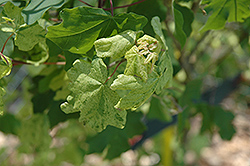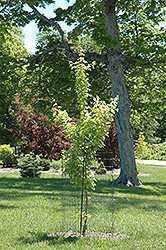Pulverulentum Hedge Maple
Acer campestre 'Pulverulentum'
Height: 12 feet
Spread: 15 feet
Sunlight:
![]()
Hardiness Zone: 5
Other Names: Variegated Field Maple, Dusty Hedge Maple
Description:
This unusual maple has cream coloured foliage with splashes of green; the compact habit of this maple makes it perfect as an accent in a garden or smaller yard; will brighten a partly shaded area where it prefers to grow, best with some shelter
Ornamental Features
Pulverulentum Hedge Maple is primarily valued in the landscape or garden for its decidedly oval form. It has attractive green-spotted creamy white foliage. The glossy lobed leaves are highly ornamental and turn an outstanding yellow in the fall.
Landscape Attributes
Pulverulentum Hedge Maple is a multi-stemmed deciduous shrub with a shapely oval form. Its average texture blends into the landscape, but can be balanced by one or two finer or coarser trees or shrubs for an effective composition.
This is a relatively low maintenance shrub, and should only be pruned in summer after the leaves have fully developed, as it may 'bleed' sap if pruned in late winter or early spring. It has no significant negative characteristics.
Pulverulentum Hedge Maple is recommended for the following landscape applications;
- Accent
- Hedges/Screening
Planting & Growing
Pulverulentum Hedge Maple will grow to be about 12 feet tall at maturity, with a spread of 15 feet. It has a low canopy with a typical clearance of 2 feet from the ground, and is suitable for planting under power lines. It grows at a slow rate, and under ideal conditions can be expected to live for 50 years or more.
This shrub should be grown in a location with partial shade or which is shaded from the hot afternoon sun. It prefers to grow in average to moist conditions, and shouldn't be allowed to dry out. It is not particular as to soil type, but has a definite preference for alkaline soils. It is somewhat tolerant of urban pollution, and will benefit from being planted in a relatively sheltered location. This is a selected variety of a species not originally from North America.

